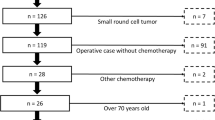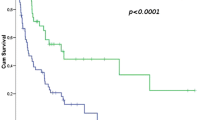Abstract
Background
Good local control of high-grade non-small round cell soft tissue sarcomas (NSRCSTSs) has been achieved with significant advances in surgical techniques and radiotherapy. However, the role of chemotherapy remains controversial. Our aim was to investigate the efficacy, feasibility and adverse effects of neoadjuvant and adjuvant chemotherapy with modified mesna, adriamycin, ifosfamide and dacarbazine (MAID) regimen for NSRCSTSs.
Methods
We conducted a retrospective review of 40 consecutive patients (29 men, 11 women; median age 47 years) with high-grade NSRCSTSs treated in two referral centers between 2004 and 2009 (median follow-up 38.5 months). Patients with distant or nodal metastases at diagnosis were excluded. The regimen consisted of ifosfamide 2,500 mg/m2/6 h (days 1–3), mesna 2,500 mg/m2/6 h (days 1–3), tetrahydropyranyl adriamycin 20 mg/m2/0.5 h (days 1–3), and dacarbazine 300 mg/m2/1 h (days 1–3).
Results
Among the 26 evaluable patients, there were 8 with a partial response, 15 with stable disease, and 3 with progressive disease. Two- and 5-year overall survival rates were 92 and 86%, respectively, and corresponding disease-free survival rates were 80 and 77%. All relapses were metastases without local recurrence. Grade 3–4 neutropenia, anemia and thrombocytopenia were observed in 38, 18, and 21 patients, respectively. No serious infectious complications occurred due to the administration of granulocyte colony-stimulating factor and prophylactic antibiotics. No other life-threatening serious adverse events were observed.
Conclusion
The modified MAID regimen achieved a better outcome with less serious adverse events than previously reported and is a potential option in the management of NSRCSTSs. Further evaluation with long-term follow-up is required.



Similar content being viewed by others
References
Trojani M, Contesso G, Coindre JM et al (1984) Soft-tissue sarcomas of adults; study of pathological prognostic variables and definition of a histopathological grading system. Int J Cancer 33(1):37–42
Demetri GD, Elias AD (1995) Results of single-agent and combination chemotherapy for advanced soft tissue sarcomas. Implications for decision making in the clinic. Hematol Oncol Clin North Am 9(4):765–785
Casali P, Pastorino U, Azzarelli A et al (1993) Perspectives on anthracyclines plus ifosfamide in advanced soft tissue sarcomas. Cancer Chemother Pharmacol 31(Suppl 2):S228–S232
Kawai A, Umeda T, Wada T et al (2005) Alternating sequential chemotherapy with high-dose ifosfamide and doxorubicin/cyclophosphamide for adult non-small round cell soft tissue sarcomas. J Orthop Sci 10(3):258–263
Leyvraz S, Bacchi M, Cerny T et al (1998) Phase I multicenter study of combined high-dose ifosfamide and doxorubicin in the treatment of advanced sarcomas. Swiss Group for Clinical Research (SAKK). Ann Oncol 9(8):877–884
Loehrer PJ Sr, Sledge GW Jr, Nicaise C et al (1989) Ifosfamide plus doxorubicin in metastatic adult sarcomas: a multi-institutional phase II trial. J Clin Oncol 7(11):1655–1659
Schutte J, Mouridsen HT, Stewart W et al (1990) Ifosfamide plus doxorubicin in previously untreated patients with advanced soft tissue sarcoma. The EORTC Soft Tissue and Bone Sarcoma Group. Eur J Cancer 26(5):558–561
Elias A, Ryan L, Sulkes A et al (1989) Response to mesna, doxorubicin, ifosfamide, and dacarbazine in 108 patients with metastatic or unresectable sarcoma and no prior chemotherapy. J Clin Oncol 7(9):1208–1216
Blay JY, Le Cesne A (2009) Adjuvant chemotherapy in localized soft tissue sarcomas: still not proven. Oncologist 14(10):1013–1020
Meric F, Milas M, Hunt KK et al (2000) Impact of neoadjuvant chemotherapy on postoperative morbidity in soft tissue sarcomas. J Clin Oncol 18(19):3378–3383
Schuetze SM, Patel S (2009) Should patients with high-risk soft tissue sarcoma receive adjuvant chemotherapy? Oncologist 14(10):1003–1012
Sarcoma Meta-analysis Collaboration (1997) Adjuvant chemotherapy for localised resectable soft-tissue sarcoma of adults: meta-analysis of individual data. Lancet 350(9092):1647–1654
Le Cesne A, Van Glabbeke M, Woll PJ et al (2008) The end of adjuvant chemotherapy (adCT) era with doxorubicin-based regimen in resected high-grade soft tissue sarcoma (STS): pooled analysis of the two STBSG-EORTC phase III clinical trials. J Clin Oncol 26(15 Suppl):559s
Gortzak E, Azzarelli A, Buesa J et al (2001) A randomised phase II study on neo-adjuvant chemotherapy for ‘high-risk’ adult soft-tissue sarcoma. Eur J Cancer 37(9):1096–1103
DeLaney TF, Spiro IJ, Suit HD et al (2003) Neoadjuvant chemotherapy and radiotherapy for large extremity soft-tissue sarcomas. Int J Radiat Oncol Biol Phys 56(4):1117–1127
Grobmyer SR, Maki RG, Demetri GD et al (2004) Neo-adjuvant chemotherapy for primary high-grade extremity soft tissue sarcoma. Ann Oncol 15(11):1667–1672
Meric F, Hess KR, Varma DG et al (2002) Radiographic response to neoadjuvant chemotherapy is a predictor of local control and survival in soft tissue sarcomas. Cancer 95(5):1120–1126
Pisters PW, Patel SR, Varma DG et al (1997) Preoperative chemotherapy for stage IIIB extremity soft tissue sarcoma: long-term results from a single institution. J Clin Oncol 15(12):3481–3487
Eilber FC, Rosen G, Eckardt J et al (2001) Treatment-induced pathologic necrosis: a predictor of local recurrence and survival in patients receiving neoadjuvant therapy for high-grade extremity soft tissue sarcomas. J Clin Oncol 19(13):3203–3209
Pezzi CM, Pollock RE, Evans HL et al (1990) Preoperative chemotherapy for soft-tissue sarcomas of the extremities. Ann Surg 211(4):476–481
Conflict of interest
The authors declare that they have no conflict of interest.
Author information
Authors and Affiliations
Corresponding author
About this article
Cite this article
Ogura, K., Goto, T., Imanishi, J. et al. Neoadjuvant and adjuvant chemotherapy with modified mesna, adriamycin, ifosfamide, and dacarbazine (MAID) regimen for adult high-grade non-small round cell soft tissue sarcomas. Int J Clin Oncol 18, 170–176 (2013). https://doi.org/10.1007/s10147-011-0360-x
Received:
Accepted:
Published:
Issue Date:
DOI: https://doi.org/10.1007/s10147-011-0360-x




